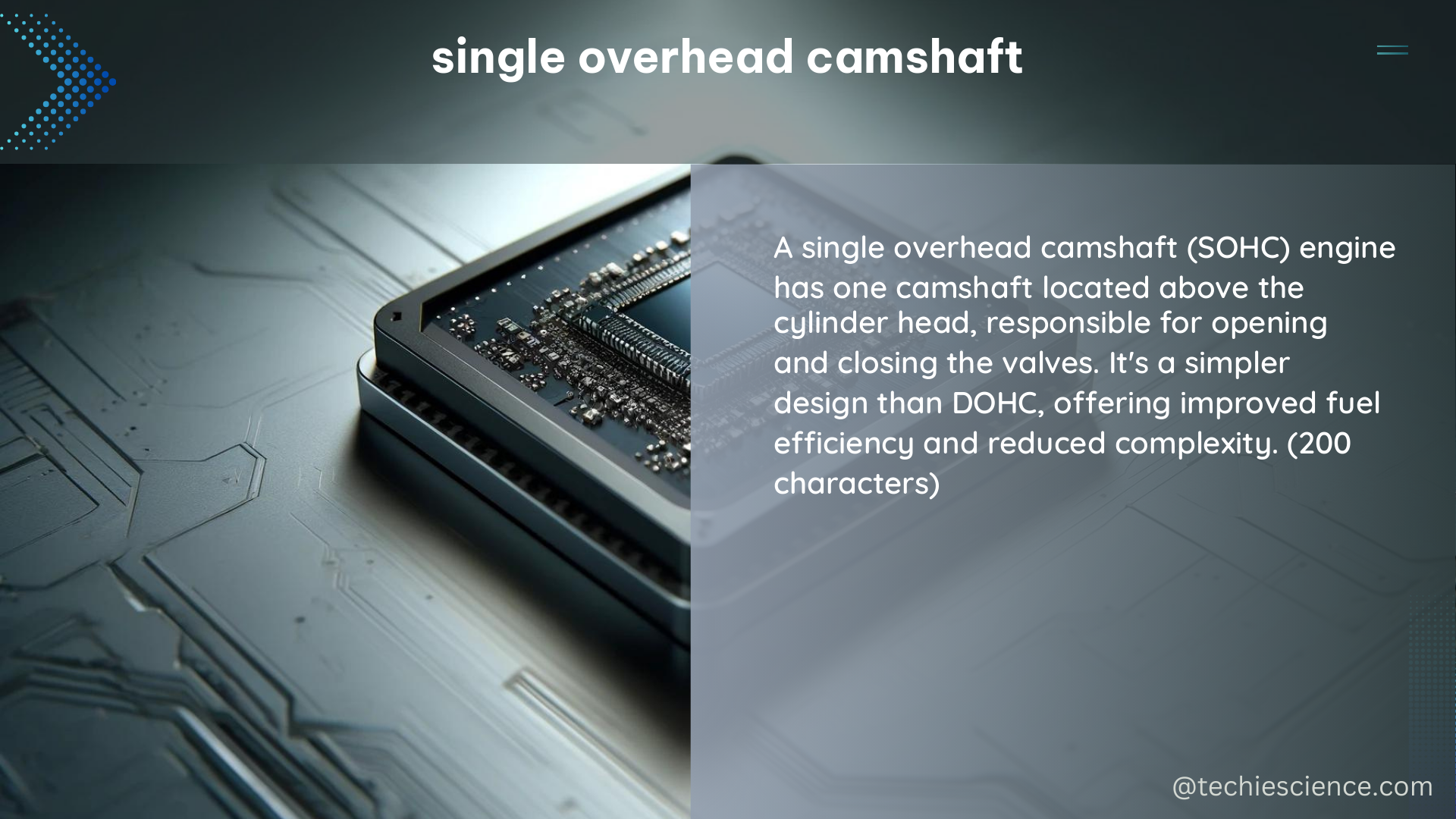Single Overhead Camshaft (SOHC) engines are a popular and cost-effective design choice for many automobile manufacturers, particularly for naturally aspirated (NA) vehicles. These engines feature a single camshaft located in the cylinder head, responsible for operating both the intake and exhaust valves. While the SOHC design offers several advantages, it also comes with some limitations when compared to the more complex Double Overhead Camshaft (DOHC) configuration.
Understanding the SOHC Design
The SOHC engine design is characterized by a single camshaft situated in the cylinder head, which controls the opening and closing of the intake and exhaust valves. This design is simpler and more cost-effective than the DOHC setup, which utilizes two separate camshafts – one for the intake valves and one for the exhaust valves.
Valve Configuration
One of the key differences between SOHC and DOHC engines is the number of valves per cylinder. SOHC engines typically have fewer valves per cylinder, often featuring two intake and two exhaust valves, for a total of four valves per cylinder. In contrast, DOHC engines can have up to four intake and four exhaust valves, for a total of eight valves per cylinder.
The fewer valves in a SOHC engine can limit its performance and efficiency, as the airflow and fuel delivery are not as optimized as in a DOHC engine. However, the simpler valve train design of a SOHC engine can also contribute to its reliability and lower maintenance costs.
Camshaft Adjustability
Another notable difference between SOHC and DOHC engines is the adjustability of the camshaft. In a SOHC engine, the intake and exhaust cam lobes are located on the same camshaft, which can limit the engine’s ability to optimize airflow and fuel efficiency, particularly at high RPMs.
DOHC engines, on the other hand, have separate camshafts for the intake and exhaust valves, allowing for more precise control and adjustment of the valve timing. This increased adjustability can lead to improved engine performance and efficiency, especially at higher engine speeds.
Measuring the Impact of Camshafts

The camshaft in an engine can have a significant impact on its overall performance, as it is responsible for the precise timing and control of the valve opening and closing. One way to quantify this impact is by measuring the parasitic load of the camshaft.
A study on a DOHC engine found that the camshaft represented approximately 5-6% of the engine’s total parasitic load. While this study did not focus specifically on SOHC engines, it provides a general sense of the impact that camshafts can have on engine performance.
Parasitic load refers to the energy lost due to the mechanical components of the engine, such as the crankshaft, bearings, and camshaft. This energy is not directly converted into useful work, but rather is dissipated as heat or friction, reducing the overall efficiency of the engine.
By understanding the parasitic load of the camshaft, engineers can optimize the design and operation of the engine to minimize these losses and improve overall performance and fuel efficiency.
Advantages of the SOHC Design
Despite the limitations of the SOHC design, it offers several advantages that have made it a popular choice for many manufacturers:
-
Cost-Effectiveness: The simpler SOHC design is generally less expensive to manufacture than the DOHC configuration, making it a more cost-effective option for many automakers.
-
Reliability: The fewer moving parts in a SOHC engine can contribute to its overall reliability and lower maintenance requirements.
-
Suitability for NA Engines: SOHC engines are well-suited for naturally aspirated (NA) applications, where the focus is on cost-effectiveness and reliability rather than outright performance.
-
Compact Packaging: The single camshaft design of a SOHC engine can allow for a more compact and space-efficient packaging within the engine bay, which can be beneficial for certain vehicle designs.
Limitations of the SOHC Design
While the SOHC design offers several advantages, it also has some limitations when compared to the DOHC configuration:
-
Fewer Valves per Cylinder: As mentioned earlier, SOHC engines typically have fewer valves per cylinder, which can limit their performance and efficiency.
-
Limited Adjustability: The shared camshaft for intake and exhaust valves in a SOHC engine can limit the engine’s ability to optimize airflow and fuel efficiency, particularly at high RPMs.
-
Reduced Volumetric Efficiency: The fewer valves in a SOHC engine can result in reduced volumetric efficiency, which is the measure of how effectively the engine can draw in and expel air and fuel.
-
Potential for Increased Emissions: The limited adjustability of the SOHC design can make it more challenging to meet strict emissions regulations, particularly in modern, high-performance engines.
Conclusion
Single Overhead Camshaft (SOHC) engines offer a cost-effective and reliable solution for many automobile manufacturers, particularly in the realm of naturally aspirated vehicles. While the SOHC design has some limitations compared to the more complex DOHC configuration, it remains a popular choice due to its simplicity, compact packaging, and suitability for certain applications.
By understanding the technical details and trade-offs of the SOHC design, engineers and enthusiasts can make informed decisions about the best engine configuration for their specific needs and requirements.
References:
– NASIOC Forum Thread on SOHC vs. DOHC
– DoD EVMSIG – Parasitic Load Measurement
– CR4 Global Spec Thread – Camshaft Parasitic Load

The lambdageeks.com Core SME Team is a group of experienced subject matter experts from diverse scientific and technical fields including Physics, Chemistry, Technology,Electronics & Electrical Engineering, Automotive, Mechanical Engineering. Our team collaborates to create high-quality, well-researched articles on a wide range of science and technology topics for the lambdageeks.com website.
All Our Senior SME are having more than 7 Years of experience in the respective fields . They are either Working Industry Professionals or assocaited With different Universities. Refer Our Authors Page to get to know About our Core SMEs.